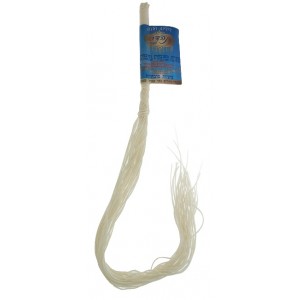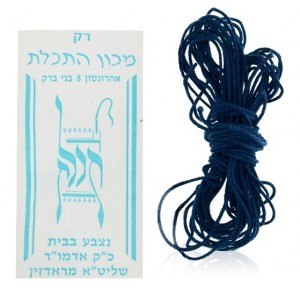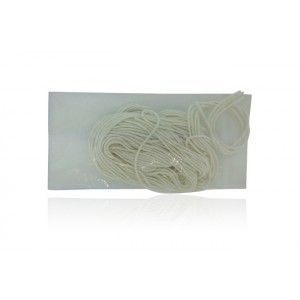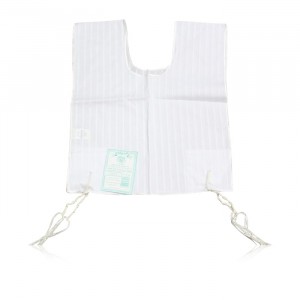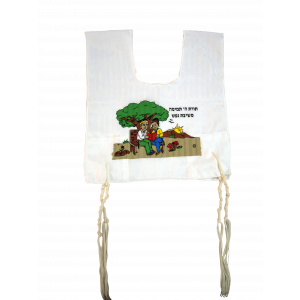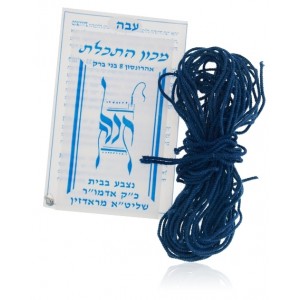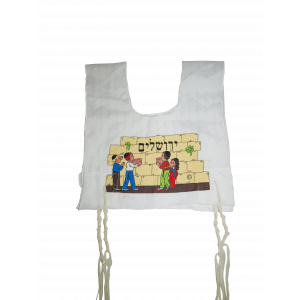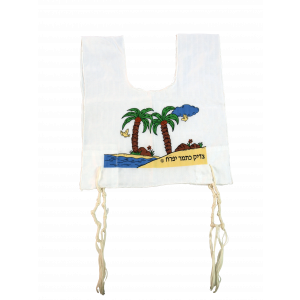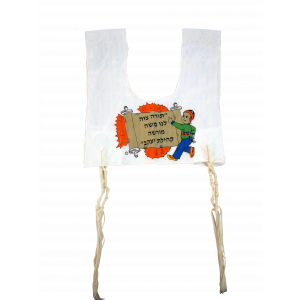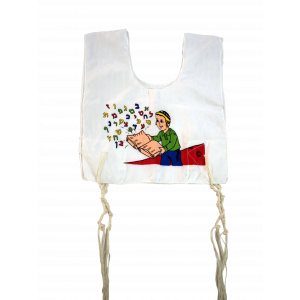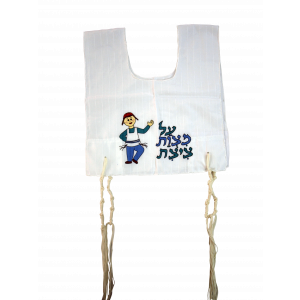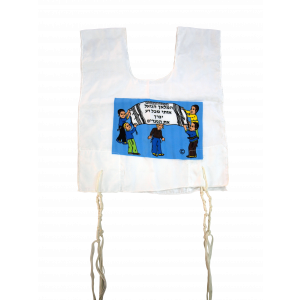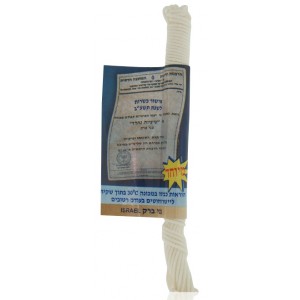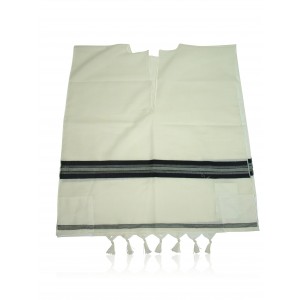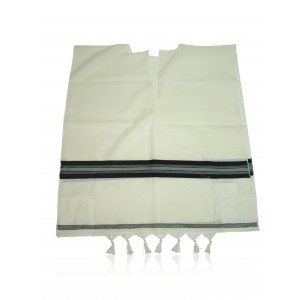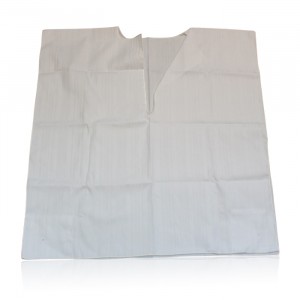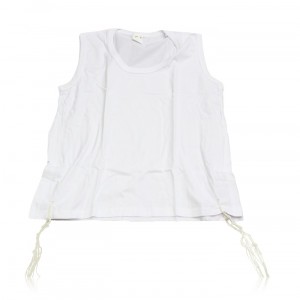Tzitzit
One of the first commandments performed in a boy’s lifetime is that of Tzitzit, also known as Tzitzis. We are commanded to wear fringes on a four-cornered garment, which is normally worn all day.
The garment to which the tzitzit are attached looks like a white poncho. It has a head hole and is open on the sides. There are typically one or two holes by each corner; these holes are where the strings are tied to the garment. The tzitzis garment is worn like a poncho, usually under whatever shirt is being worn that day and it covers the torso of the body. Most often the white wool tzitzit strings will be tied together with blue techelet threads.
Thin tzitzit will be a better choice for Tallit Katan, whereas on Tallit Gadol, both are fine. Thin Tzitzit are often machine-spun (machine-made), while thick tzitzit are handmade, and also called ‘Avodat Yad’. In traditional Orthodox congregations, thick tzitzit are the norm. Among the Modern Orthodox, you will see both, although thick tzitzit are probably more common.
There are three main shitot (methods) how to wrap the strings: Ra’avad, Rambam and Radzyner to tying the techelet and tzitzit strings. To learn more about these methods read our more detailed article on Tzitzit & tekhelet.
There are a few options when picking out a tzitzit garment. The most popular is a tzitzit garment made of cotton. This garment is light and is practically unnoticeable by the wearer. For those who are partial to fulfilling the commandment by the strict opinion, there are Tzitzit garments made of wool. These garments are heavier and typically have either black or white strips across the bottom. They also have knotting along the front bottom edge similar to what is found on a Tallit. Tzitzit come in the shape of a T-shirt worn under clothing so they do not require Tallit Clips the way Tallit prayer shawls do. Wool tzitzit garments tend to be more expensive than cotton tzitzit.
For those who want to combine an undershirt with their Tzitzit garment, there is T-Shirt Tzitzit. This style of tzitzit looks like a T-Shirt cut halfway up the middle of the sides. Like all other styles of tzitzis, there are holes by the corners where you can tie the strings. This style is perfect for children.
For those who do not want to tie their own tzitzit strings, you can buy a tzitzit garment with the strings already tied. These tzitzit garments are the most expensive and since the strings are already tied, your options are based how the strings are tie and therefore your options of tzitzit garments are based on the strings, which are tied either as Rashi, Rabbeinu Tam or Rambam. These tzitzit make for good Bar Mitzvah gifts. And for those who wish to have blue strings on their tzitzit strings, there are numerous options available. Like those without blue strings, your options are based on how the strings are tied; however your options include Radzyner, Rav Amram Ga’on, Rambam, Ra’avad, Tosafot, Baal HaTur, Vilna Ga’on, Sefer HaHinuch, Chabad and Yeshiva University, as well as Rashi and Rabbeinu Tam. These are the most expensive tzitzit you can buy and will keep you looking your finest during Jewish Holidays. Feel free to contact us if you have any questions regarding Tzitzit.
Tzitzit Guide
One of the commandments upon men is the wearing of Tzitzit on each of the edges of a four cornered garment. In the fact, the wearing of Tzitzit is one of the first commandments a boy performs in his lifetime with many children as young as three wearing Tzitzit. The commandment of wearing Tzitzit appears in the Books of Numbers and Deuteronomy.
What are Tzitzit?
Tzitzit are the sets of fringed strings that are attached to a poncho-like garment typically made of either cotton or wool also known as Tzitzit. As such, the term Tzitzit is often used it to refer to both the garment and the strings. However, Tzitzit strings are also tied to the corners of a Tallit and the two have the same rules governing their use in Jewish Law.
Decorations
The vast majority of Tzitzit sets are undecorated, with the most elaborate sets having a few black stripes along the bottom front edge in imitation of a Tallit. However, children’s Tzitzit sets are decorated, although the designs are usually something Judaica related like a child saying the Shema prayer or objects such as cars, planes and building blocks. The strings that are tied to a Tzitzit garment are never decorated. It should be noted that the strings used with a Tzitzit garment are usually wool and because of a biblical prohibition may never be worn with a garment that is made from linen.
Strings
Tzitzit strings are the most complicated areas of Tzitzit sets. Typically, each set of Tzitzit strings includes four long strings and nine short strings, all of which are white. There are several different methods of tying Tzitzit strings, all of which are based on the interpretation of traditional Jewish texts. The most common two methods are Rashi and Rabbeinu Tam, two Rabbis from the 10th and 12th centuries. Those two styles, while they have slight differences, typically have strings in groups of 7, 8, 11 and 13 in between double knots. Other styles include Radzyner, Arizal, Rambam and Gr”a; these tying methods tend to differ heavily from the other two methods.
On alternative regarding Tzitzit strings is to include the blue string called Techelet on each corner. These Tzitzit strings may be tied in several different manners, again in conjunction with legal rulings and consequently the number of blue strings varies. Tzitzit with the Techelet string have resurged in popularity over the last few years and are worn by most orthodox Jews.
For More Information
For more information on
Tzitzit,
Judaica, or
synagogue items, feel free to
contact our Judaica experts with any questions or concerns.

